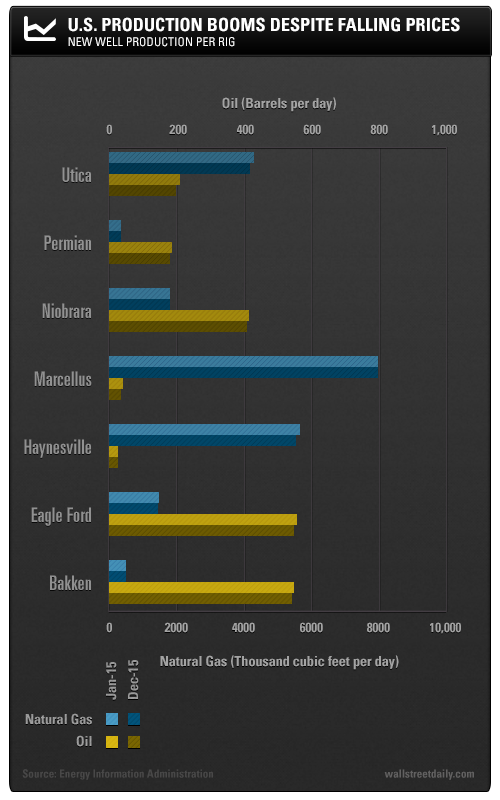Well, it looks like OPEC’s plot to run U.S. oil out of business has failed. At least, for now.
The U.S. Energy Information Administration (EIA) has released the official numbers in its December Drilling Productivity Report (DPR).
Despite plummeting crude oil and natural gas prices, drillers across the U.S. do not appear to be slowing down.
But will these productions levels last if prices stay low?
The answer to that is complicated.
A Swing and a Miss
Since its formation in 1960, OPEC has become an instrumental force on influencing global crude oil prices. Today, it produces over 39% of the global supply of petroleum.
The cartel is skilled at tweaking production among its member states to dictate global prices.
On November 27, the world awaited the outcome of OPEC’s 166th meeting, expecting a cut in crude production to boost the already plummeting price of oil. (An announcement of a cutback would have immediately instigated a spike in the futures markets.)
But in a bold move, OPEC chose not to cut back in an effort to cull the competition and run some of the smaller U.S. driller out of business.
But so far, that doesn’t appear to be happening…
According to the DPR, this coming January wells are expected to yield more oil and natural gas than December 2014.
Proof in the Pudding
Indeed, the data shows that the United States’ seven most prolific oil and gas regions are expected to increase their production by 116 thousand barrels per day of oil and 626 million cubic feet per day of natural gas.
These seven regions accounted for 95% of domestic oil production growth, and all domestic natural gas production growth from 2011 to 2013.

In order to arrive at these estimates, the DPR assesses how and where drilling for hydrocarbons is taking place. It uses recent data on the total number of drilling rigs in operation – along with estimates of drilling productivity and changes in production from existing wells – to provide estimated changes in oil and natural gas production for the seven key oil fields.
Readers should note that the EIA doesn’t distinguish between oil-directed rigs and gas-directed rigs, because once a well is completed, it may produce both oil and natural gas. In fact, more than 50% in the seven major fields do just that.
On top of the DPR data, the Baker Hughes Rig Count says there are more drilling rigs in operation now than there were this time last year, not only in North America but in other regions, as well. This is significant when you consider that energy prices were much higher a year ago than they are now.
So what does all of this mean for the price of oil and natural gas and the companies that drill for them?
The most immediate issue in this new climate is whether these low prices are sustainable.
It’s a Secular Thing
The question of sustainability is really secular, instead of cyclical. There are a number of macro factors affecting both supply and demand.
Japan is in a recession, and Europe is heading for one. China is tightening its credit, putting pressure not only on neighboring economies but on all of its trading partners.
The United States continues to expand its shale drilling, and yields have been increasing as a result of hydraulic fracking and enhanced recoveries of pre-fracked wells. Plus, the dollar remains relatively strong, which is a negative for global commodity prices. While the United States looks solid from an equity market standpoint, energy stocks have taken a beating.
Considering all that, we’ll likely face soggy energy commodity and energy equity prices, at least for the short to medium term.
But don’t get comfortable at these levels.
Any sign of future cutbacks, production disruptions, or heightened geopolitical tensions in the Middle East can easily trigger spikes across the board in all of these instruments.
So be alert and nimble to macro events that could turn these markets on a dime – we’ve been there before… and we could easily see a reversal again.
One thing appears certain, though, more volatility lies ahead.
Good investing,
